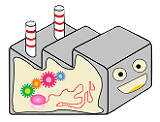Circular RNA
- Project Detail
- Progress
- Materials and Methods
- The Experiments
- Result
- Data analysis
- Conclusion
In vivo, proteins are synthesized in transcription and translation.
Generally, mRNA is single-strand RNA, starting translation by binding ribosome on initiation codon, and ending by separating ribosome from mRNA.
In this study, we aim to build the method of synthesizing long-chain, massive proteins and to improve translation efficiency.
That is, allowing ribosomes to have a semi-permanent translation mechanism by producing circular mRNA and causing a defect of termination codon.
To cyclize mRNA, we can use a splicing mechanism of T4 phage.
Splicing is a mechanism removing circular introns which don't code for proteins and joining in exons which code for ones.
It occurs after transcription.
Splicing is catalyzed by several base sequences of the ends of introns as a ribozyme, being subjected to nucleophilic attack from introns to exons.
So we will introduce the plasmids which place the sequence of the end of introns as a splicing ribozyme on the end of a gene coding for proteins into E.coli, and cyclize mRNA for
synthesis of long-chain, massive proteins.
Theme of our project
-
Transform new year's card to rice cake
(make cellulose resolve and reconstruct it to synthesize amylopectin)
-
RNA shaped like a ring / ring-shaped RNA
(mass-produce protein by ring-shaped RNA)
Description
-
In vivo, proteins are synthesized in transcription and translation.
Generally, mRNA is single-strand RNA, starting translation by binding ribosome on initiation codon, and ending by separating ribosome from mRNA.
In this study, we aim to build the method of synthesizing long-chain, massive proteins and to improve translation efficiency.
That is, allowing ribosomes to have a semi-permanent translation mechanism by producing circular mRNA and causing a defect of termination codon.
To cyclize mRNA, we can use a splicing mechanism of T4 phage.
Splicing is a mechanism removing circular introns which don't code for proteins and joining in exons which code for ones.
It occurs after transcription.
Splicing is catalyzed by several base sequences of the ends of introns as a ribozyme, being subjected to nucleophilic attack from introns to exons.
So we will introduce the plasmids which place the sequence of the end of introns as a splicing ribozyme on the end of a gene coding for proteins into E.coli, and cyclize mRNA for
synthesis of long-chain, massive proteins.




 "
"